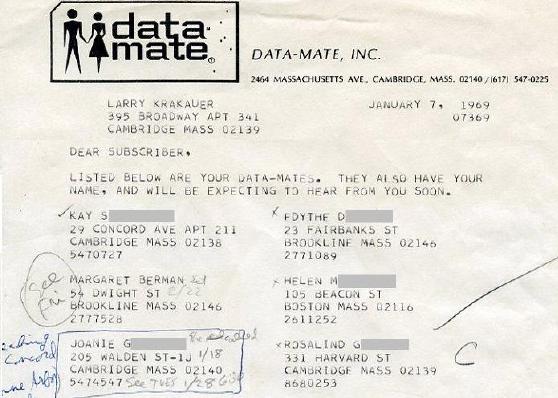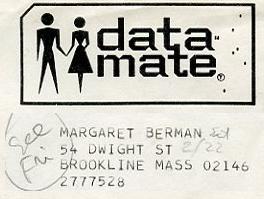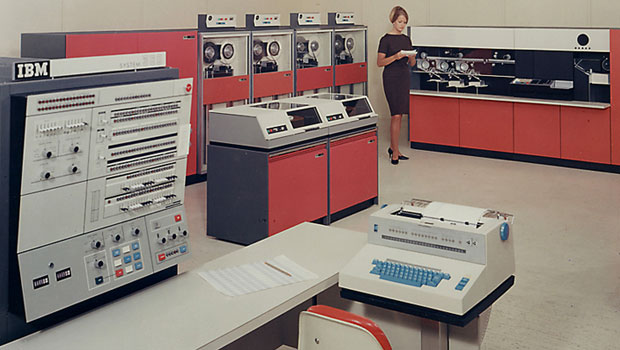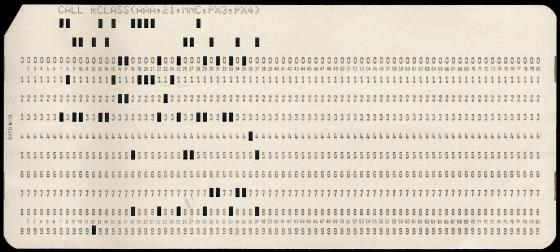
At the time, I was a graduate student at the Massachusetts Institute of Technology ("MIT"), in Cambridge, Massachusetts, aiming to complete my Ph.D. degree in June of 1970. In the early sixties, I met most women through introductions by friends (generally called "fix-ups"). But by 1966, I was 24 years old, and most of my friends had already married. They then generally knew fewer single women, so my sources of fix-ups dried up. And while MIT today has almost as many female as male students, in the mid sixties, it was a largely male environment. I did date an MIT secretary or two (they were sometimes called "Techretaries"), but nothing lasting came of it. Then, in March of 1965, a computerized dating service called "Operation Match" appeared on the scene, founded by three students at nearby Harvard University. Here's a 1965 article from the Harvard Crimson, about its origins. Note 1
Programs and data were entered on those punched cards, which were officially called "Hollerith" cards, but which most people called "IBM cards". The cards actually pre-dated the computers, having been long used by businesses, which processed them with a variety of mostly mechanical tabulating and sorting equipment. But when computers came along, the cards were already available to be used as an input/output medium.
I hope you're not thinking I signed up for Operation Match on-line, as is done these days for services such as Match.com and many others. There was no such thing as "on-line", as the internet didn't exist. Rather, we filled out paper multiple-choice questionnaires, put them into a stamped envelope along with a check for $3.00, and sent them off via what is now called by the retronym "snail-mail". Our responses to the survey were probably keypunched onto Hollerith cards and batch-processed, and within a week or so, we received a letter containing suggested matches. The first time I used one of these services was in 1965, and it was Operation Match, not Data-Mate. Here's the first list I received, in October of that year. I've blocked out all but the first letter of the last names of my matches, but left the addresses and telephone numbers, which are now over 48 years old, and surely no longer valid. The image below shows only the top of the letter, with some blank space removed, but if you click on it, you can see a bigger image of the entire letter (you may need to click a second time to enlarge it):  I used Operation Match to meet women in 1965, 1966, and 1967 - I have three different Operation Match letters sent to three different addresses. Then in 1968 and 1969, I switched to the service Data-Mate, for reasons which I no longer recall (perhaps because it came out of MIT as opposed to Harvard). Here's the top portion, compressed, of the letter by which I was introduced to Margie in 1969 (again, click on it to see the whole thing):  They misspelled Margret's first name. I'm sure she had spelled it correctly on the form she submitted, but almost everyone misspells it nevertheless. Margie was apparently not the first person I called from that list. From notations you can see on the list, it seems I had gone out with Joanie G. on January 28. I also noted that Joanie had called me. Generally it was the men who initiated telephone contact, but the women sometimes called as well. My first date with Margie wasn't until Friday, February 7. We had a reasonably long telephone conversation earlier that week, and I wrote on the list "Sat 2/22", making a note of her upcoming twenty-fifth birthday. I'll say more about our first date in my next blog entry. An MIT classmate and friend also made much use of these early dating services. He made more of a science of it than I did. He submitted several questionnaires, answering the questions a bit differently on each, using slightly different names to allow him to match each of the lists he received with its corresponding questionnaire. That way, he could see which questionnaire answers yielded the most compatible matches. In January, 2011, I was contacted by author Daniel Slater, who was researching a book that was to include material on the early computerized dating services. He had come across one of my web pages in which I had mentioned Data-Mate. We arranged to speak by telephone, and he interviewed me about my experiences. I scanned all my Operation Match and Data-Mate letters, nine of them, and sent them to him. Note 2 In August, 2011, he wrote me that he had sold his book proposal to Penguin. The book has now been released, under two titles, actually. It was released in hard cover as Love in the Time of Algorithms: What Technology Does to Meeting and Mating. In soft cover, it's called A Million First Dates, Solving the Puzzle of Online Dating. Although I just became aware of it, and haven't read it yet (although I intend to), enough is available on-line to see that I've been quoted in at least one paragraph:
And Dan spelled Margret's name correctly! I'll have more about our first date in next week's blog entry, to be called Data-Mate (bis).   Note 1: Interestingly, one of the founders of Operation Match, Douglas Ginsburg, was later nominated to serve on the United States Supreme Court. However, he was forced to withdraw his nomination after admitting he had smoked marijuana. How times have changed - there's now a trend towards the legalization of marijuana in many states. [return to text] Note 2: Having used these services for five years, why do I have nine letters? It appears that Operation Match only sent me a single letter for each questionnaire I submitted, one each in 1965, 1966, and 1967. But note the sentence at the bottom of the Data-Mate letter: "YOU WILL HEAR FROM US AGAIN AS SOON AS THERE ARE NEW DATA-MATE SUBSCRIBERS WITH WHOM YOU ARE COMPATIBLE." I received three letters in response to each questionnaire I submitted to Data-Mate, one in 1968 and one in 1969. That means that I got two more letters, containing a total of 12 additional names, after the letter that introduced me to Margie. But by then, I was no longer interested in finding a match. Some of you may be wondering why everything in these letters is in UPPER-CASE (nowadays, we would consider that to be SHOUTING). The highest-speed printers in the sixties were of a type called "line printers", which printed an entire line of characters at once. Most early line printers printed only in upper-case. Wikipedia has a good article on line printers. [return to text]
 |
 In February, 1969, I met my wife-to-be Margie using the early computerized dating service Data-Mate. You can see the contact information I was sent to the left (edited down to the essentials - you'll be able to see the whole letter below, if you're interested).
In February, 1969, I met my wife-to-be Margie using the early computerized dating service Data-Mate. You can see the contact information I was sent to the left (edited down to the essentials - you'll be able to see the whole letter below, if you're interested).

